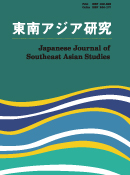7 巻, 2 号
選択された号の論文の15件中1~15を表示しています
- |<
- <
- 1
- >
- >|
論文
-
1969 年7 巻2 号 p. 148-162
発行日: 1969/09/30
公開日: 2019/06/06
PDF形式でダウンロード (710K) -
1969 年7 巻2 号 p. 163-176
発行日: 1969/09/30
公開日: 2019/06/06
PDF形式でダウンロード (1057K) -
1969 年7 巻2 号 p. 177-190
発行日: 1969/09/30
公開日: 2019/06/06
PDF形式でダウンロード (815K)
資料・研究ノート
-
1969 年7 巻2 号 p. 191-197
発行日: 1969/09/30
公開日: 2019/06/06
PDF形式でダウンロード (386K) -
1969 年7 巻2 号 p. 198-208
発行日: 1969/09/30
公開日: 2019/06/06
PDF形式でダウンロード (687K)
報告
-
1969 年7 巻2 号 p. 209-216
発行日: 1969/09/30
公開日: 2019/06/06
PDF形式でダウンロード (829K)
書評
-
1969 年7 巻2 号 p. 217-225
発行日: 1969/09/30
公開日: 2019/06/06
PDF形式でダウンロード (901K)
図書紹介
-
1969 年7 巻2 号 p. 226
発行日: 1969/09/30
公開日: 2019/06/06
PDF形式でダウンロード (157K) -
1969 年7 巻2 号 p. 226-227
発行日: 1969/09/30
公開日: 2019/06/06
PDF形式でダウンロード (255K) -
1969 年7 巻2 号 p. 227-228
発行日: 1969/09/30
公開日: 2019/06/06
PDF形式でダウンロード (268K) -
1969 年7 巻2 号 p. 228
発行日: 1969/09/30
公開日: 2019/06/06
PDF形式でダウンロード (172K)
現地通信
-
1969 年7 巻2 号 p. 229-248
発行日: 1969/09/30
公開日: 2019/06/06
PDF形式でダウンロード (1836K) -
1969 年7 巻2 号 p. 249-253
発行日: 1969/09/30
公開日: 2019/06/06
PDF形式でダウンロード (654K)
座談会
-
原稿種別: 付録等
1969 年7 巻2 号 p. 254-270
発行日: 1969/09/30
公開日: 2019/06/06
PDF形式でダウンロード (1447K)
研究短信
-
原稿種別: 付録等
1969 年7 巻2 号 p. 271-272
発行日: 1969/09/30
公開日: 2019/06/06
PDF形式でダウンロード (93K)
- |<
- <
- 1
- >
- >|
